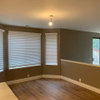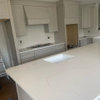How to Install Juno Trac 12 UCL
texaskitchentoo
13 years ago
Like many on here I searched for under cabinet lighting. I initially wanted LED but my top requirement was dimmable and color quality. Not many LED UCL are dimmable but a growing number are. Color quality on the LEDs was still too blueish and cool for us, so Xenon was the choice. Then as I looked for which fixtures to buy I came across Juno Trac 12. This is a low profile track system that can accept a variety of fixtures from low profile Xenon to MR11's and even LED fixtures. The LED fixtures are pretty expensive though. There are other makers of linear lighting (Seagull and Kitchler to name two) but these use a wire and piercing scheme, I thought the track system by Juno was a better design.
Part of what led me to the track system was the ability to place the fixtures anywhere along the track I wanted. I could also place as many as I wanted as long as I didn't exceed the transformer's limit (240W). If you get tired of what you have you can easily order new fixtures and replace them at will. I'm hoping that in a few years Juno will have better cheaper LED fixtures and I can uprade them with minimal effort. But if not we are very happy with the Xenon fixtures.
Instructions on how to design and install a system are not described anywhere on Juno's site. There is actually little information out there. I managed to figure it out but for others I'm going to document what I did if you are interested in the same sort of system. The same concepts will apply to any of the low voltage linear lighting products out there.
So the first step is to design your system....
Here is a link that might be useful: Juno Trac 12




texaskitchentooOriginal Author
texaskitchentooOriginal Author
Related Professionals
Hunters Creek Lighting · Evanston Furniture & Accessories · Greer Furniture & Accessories · Jacksonville Furniture & Accessories · Skokie Furniture & Accessories · Alpharetta Furniture & Accessories · Robbinsdale Furniture & Accessories · Bel Air North Interior Designers & Decorators · Fernway Interior Designers & Decorators · Westbury Interior Designers & Decorators · Clemmons Decks, Patios & Outdoor Enclosures · Midlothian Decks, Patios & Outdoor Enclosures · Parlier Decks, Patios & Outdoor Enclosures · West Hills Decks, Patios & Outdoor Enclosures · Westminster Decks, Patios & Outdoor EnclosurestexaskitchentooOriginal Author
texaskitchentooOriginal Author
rosiew
dim4fun
texaskitchentooOriginal Author
rlraucci
texaskitchentooOriginal Author